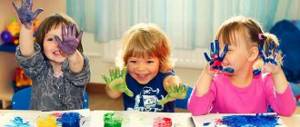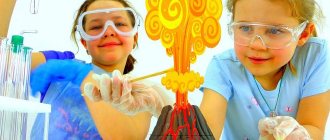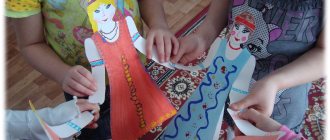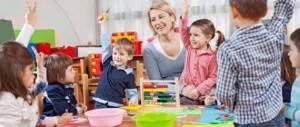Creative abilities of preschool children
Creative abilities, like intellectual ones, belong to the group of cognitive abilities. Only the main load falls on various cognitive processes. In intellectual cognition, thinking plays a leading role, and in creative cognition, imagination plays a leading role. Therefore, the creative abilities of preschoolers begin to develop later - in the second half of preschool childhood.
A child can try on pyramid rings to fit them to size as early as two years of age. This indicates his intellectual development. But a preschooler will be able to see a new image in the same pyramid, calling it “girl”, “slide”, etc., when he receives numerous ideas about the world, comprehends analogies and activates his imagination.
The creative abilities of preschool children are an original approach to understanding the environment, a tendency to find non-standard ways and means of solving problems, and a desire to obtain original results.
Children can realize their creative potential in any type of activity. By drawing or constructing a structure, performing actions with toys, or being carried away by role-playing games, preschoolers are guided by their plan. Since the plan is formed on the basis of how the child perceives the surrounding reality, it can reflect a typical picture, but it can also be very unusual.
Directions for the development of children's creative abilities
Creativity rarely develops on its own. Their development needs stimulation. For this reason, it is important to know in what directions the creative abilities of preschoolers can be developed. There are two effective lines:
- Complicating actions in using means to implement plans
- Expanding the set of tools to solve a specific problem
As an example, consider how children use a bucket. In addition to its direct purpose, it can serve as a form for Easter cakes, the upper part of a constructed tower, a headdress, a chair, a support for a bridge, etc. But children come to this variability with the development of creativity.
The same goes for finding new means to realize your ideas. You cannot draw an outline - a preschooler will lay it out with sticks; no sticks - will line up cubes around the perimeter; there are no cubes - he will stretch out a jump rope or a strap... If there are no more or less suitable means, the older preschooler will act in imaginary circumstances.
Every time the search for suitable means and possibilities for their use is a kind of brainstorming for the creative thinking of a preschooler. Experience confirms that the most original ideas come AFTER trying more familiar options. It is important for adults to remember this fact and encourage the child’s activity in generating new ideas.
Creative abilities at different ages
At the age of 2-5 years, the basis of his personality is formed in a child, so his creative potential is revealed most clearly. At this stage, the baby is very curious, his memory is selective and based on early speech and abstract thinking. The child is characterized by firmness in achieving goals, he has increased attention, his imagination and emotional level develop. The child feels a great interest in new knowledge and skills, he is ready to use any methods of creative development.
At 6-10 years old, a child has a difficult period, because he begins to go to school and receive an education. Creative abilities at this stage depend on the circumstances of study and communication. During this period, the child wants to independently acquire knowledge.
At the age of 11-14, a child not only has many questions, but he himself can now conduct research and experiments, carry out experiments, and come up with hypotheses. Perhaps the number of his interests will decrease, but the depth of their research will be great. During adolescence, a child begins to have serious philosophical questions. What is a sense of life? What am I living for? Is there a God on Earth?
Features and signs of development of creative abilities of preschool children
The preschool period is especially favorable for the development of artistic and creative abilities.
The child gets acquainted with visual and constructive activities, pays attention to the musicality of the surrounding world, and tries his hand at creating drawings, crafts and buildings.
A clearly expressed cognitive need of a preschooler is a sign of creative potential. In addition, abilities for various types of artistic activity have specific characteristics. It is useful for parents to know how children's inclinations in certain creative areas manifest themselves.
Signs of creative abilities of preschoolers in art activities
The very way and what means a child chooses to realize his plan indicates the presence or absence of a creative approach. A few more telling signs about the presence of abilities in visual arts:
- A preschooler prefers drawing or modeling as soon as he has a choice of what to do.
- As part of the plot, it depicts a large number of objects and people.
- He chooses original subjects for his drawings. For example, he does not depict the usual house-tree-flowers, but paints a sky strewn with stars around a shining sun, and calls his picture Cosmos.
- Resorts to drawing or sculpting to express his mood and feelings.
- He uses new material with interest to implement his plans, and is also eager to try out a new medium in practice (sculpt from clay, not plasticine; draw with paints instead of pencils).
- Shows interest in works of painting and sculpture - examines, speaks out about the painting or statue he sees.
Creative talent in theatrical activities
Attentive adults notice artistic talent in a child from early preschool age, as soon as the child develops speech skills. Later, nonverbal expression comes into play, complementing the expressive signs of artistry.
- Likes to imitate colorful characters from fairy tales and cartoons, trying to convey the tone of speech and characteristic movements.
- He easily takes on any role, imagining himself either as a friendly dog, or as a dangerous wolf, or as a Wizard.
- Actively uses facial expressions, gestures and movements to convey the feelings and character of the image.
- Seeks to evoke an emotional response in others when telling something or portraying a character.
- Uses attributes (appropriate clothing, distinctive supporting details) to emphasize his suitability for the role.
- He enthusiastically watches children's performances, be it a theatrical game or a puppet show.
Signs of abilities for speech creativity in preschool age
What features should adults look for in order to notice the makings of literary talent in a preschooler:
- The child listens carefully to fairy tales and children's stories. At some plot points he stops the narrator and asks clarifying questions.
- Can compose a story himself, observing the key structure: a semblance of a plot plot, a climactic event and a final moment. For younger preschoolers, such stories can literally consist of 4-5 sentences, but the structure of the story can be traced.
- Comes up with something original when he retells a well-known story or fairy tale.
- When talking about something, he adheres to the storyline and main idea.
- Uses words that convey the experiences and feelings of the characters.
- He explains some points in particular detail so that listeners understand what is happening.
“Development of creative abilities through artistic activities”
the child’s personal position, desire to express himself;
development of abilities for visual activity (their structure includes emotional responsiveness, sensory, creative imagination, sense of color, shape, composition, manual skill);
creation of an artistic image - the child’s personal attitude, emotional response, self-affirmation, choice and preference for means of expression (picturesque, graphic, plastic, decorative silhouette); the relationship between different methods and their independent choice by children;
synthesis of art to create an artistic image, an atmosphere of emotional empathy, co-creation, i.e. focusing on individual types of art (dominant) and models of synthesis:
music, visual arts, visual activity, artistic expression (three-level model);
fine arts, fiction (two-level model);
music, fiction, theatrical activities, visual activities (multi-level model).
The joint activity of an adult and a child takes on the character of co-creation, which at each age stage has its own function (a more active role of co-creation in the early stages and a gradual change in its content at older age stages, when the teacher takes the role of an adviser, partner). At all age stages, the child’s personal position remains the main, leading one, and the teacher must take it into account. Already at school age, we can talk about nurturing in children the rudiments of artistic culture, since it is during this period of childhood that the aesthetic perception of an artistic image in a painting, sculpture, and graphics is formed; the development of abilities for visual activities occurs. The system of classes for preschool children in visual arts is aimed at teaching children to depict surrounding objects and phenomena, using for this purpose acquired visual skills and abilities, using available means of expressiveness when creating images and developing children's artistic creativity. Visual activities in kindergarten are based on the unity and interconnection of three types: drawing, modeling, appliqué, which contribute to children’s more effective mastery of all these types of activities, as well as a warmer aesthetic development of children. The effectiveness of teaching, and, consequently, the development of children's creativity and comprehensive education of children in kindergarten depends on a number of conditions. The main one is: building the learning process in accordance with the program, teaching methods aimed at children mastering all components of the activity and meeting joint requirements. The transition to pedagogy of cooperation, pedagogy of development makes it possible to effectively develop the visual abilities of preschoolers. It is important to carry out development work comprehensively. For example, introducing children to any type of decorative and applied arts in the senior or preparatory groups, a block of classes is planned in the first quarter. This block introduces Dymkovo folk art, interconnects all types of artistic activities, as well as preliminary work in a group. Wide inclusion in the pedagogical process, in the lives of children of various artistic and creative activities, maximum attention and respect for the products of children's creativity, their widespread use in the life of preschoolers and the design of the kindergarten premises fills the lives of children with new meaning, creates for them an environment of emotional well-being. By comparing their works, children are convinced of the advantages of one method or another, so they are prepared for an independent search for the best means of representation, and this in turn prepares children for creative activity, which is of a search nature. Based on the fact that each child must acquire a certain amount of knowledge, skills and abilities in an organized manner in classes and in independent free activities under the guidance of a teacher, work to familiarize children with artistic activities in kindergarten is carried out according to the following scheme: In specially organized classes with a subgroup children in the art studio solve the problems of mastering technical and visual skills, and consolidate the results of their acquaintance with the world of fine art. The reduction in the number of drawing classes is compensated by organizing children's learning during play in a group with a teacher, with gifted children in a circle in the art studio, and with lagging children in individual lessons. To ensure the organic unity of children's learning and creativity, classes include the following activities: 1. Presentation of educational material (in the form of a game, conversation, excursion). The introduction of new methods of artistic activity, new materials through creative tasks that children solve together with the teacher and individually, contributes to the solution of educational problems and assignments. 2. Independent practical work of children, which is the basis in the educational process. Her goal is creativity. The creation of artistic images develops in children the ability to generalize them, lead to unity and integrity. 3. Discussion of creative works by children and the teacher helps the child to see the world not only from his own point of view, but also from the point of view of other people, to accept and understand the interests of other people. When planning classes, it is necessary to choose one or another form of work for each topic, taking into account the complexity and volume and specifics of the art studio. Thus, the presentation of the material can take place first in a group with a teacher, and then continue in classes in the art studio, or vice versa. For example, the theme “Circus”, in order to draw it creatively, the children in the group are told a lot about the circus, during the conversation the children share their impressions of going to the circus, make sketches of clowns, animals with the teacher, and then in the lesson the children, showing creativity, create works - sculpt, draw, etc. Given the specific nature of the topic, classes can take place in an art studio, or maybe in a music room. For example, if the final lesson is in the form of entertainment. When introducing work with children in art classes, it is important to pay attention to social-emotional development, not limited to just transferring knowledge, concepts and skills to the child. It is important to encourage children to demonstrate independence and creativity in visual arts. The results of work in this direction should be: - children’s activity and independence in visual arts; — the ability to find new ways for artistic depiction; - the ability to convey one’s feelings in one’s work using various means of expression. Education in visual arts classes is structured as an exciting problem-based game activity that ensures the child’s subjective position and the constant growth of his independence and creativity. All classes are conducted in subgroups and are integrative in nature. The pedagogical process also includes individual lessons with lagging children and lessons with gifted children. Club work can be carried out with gifted children twice a week. At club classes, gifted children receive additional, deeper information about the visual arts program, and most importantly, they acquire the opportunity for unlimited creativity. In classes, close connections are established between all types of visual activities - drawing, modeling, appliqué, as well as decorative and applied work. Children's education is structured as an exciting problem-based game activity that ensures the child's subjective position and the constant growth of his independence and creativity. Activities in an enriched developmental pedagogical environment allow the child to show inquisitiveness, inquisitiveness, learn about the environment without coercion, and strive for a creative reflection of what he knows. So, during classes, children find themselves in interesting situations in which they need to figure out a way out themselves. For example, in the “Visiting King Palette” classes, children solve quite a few problems in order to get to a magical land: they put together a portrait of the king (model), together build a bridge from a rainbow, solve puzzles, etc. During the lesson, children are asked questions: what do you think? What would you do? How do you imagine it, describe it, etc. When preparing for our classes, we constantly think about what to do so that teaching images does not create cliches and does not interfere with children’s ability to depict something on their own? It is obvious that children can and should be taught. But not the artistic technique of adults, but a new vision, a new plastic understanding of space. But be sure to take into account their age characteristics. We want every drawing or completed work to be filled not with educational content, but with children’s content, so that they reflect the child’s impressions, his attitude towards what he depicts. Therefore, in art classes, we try to assign a greater role to sources of fantasy, creativity, and independence. In order for children to have a desire to complete the educational task, work is carried out to develop play motivation. For example, a fictional story is briefly but convincingly told about the problems of some game character (bunny, clown, etc.) and we encourage them to help. The main thing is to create a good attitude towards the game characters, a desire to help them, and create motivation. It is important to find out whether the children want to help the fairy-tale hero; only after an affirmative answer do we continue the lesson. For example, during a group lesson on the “Kingdom of Mushrooms” application, children help old man Lesovich collect a full basket of mushrooms (cut and paste). It is very important that a child can fulfill the noble role of an assistant and protector of the weak only by learning something new. Typically, classes are conducted according to a structure that helps to complete all tasks as much as possible.
Creating conditions for the development of creativity
Every year, the ideas and actions of a preschooler improve and become more complex. Creative abilities develop in close connection with imagination. Even without external pushing, a child is interested in discovering new horizons of his achievements. And if he is additionally carefully directed to search for non-standard solutions, the results will become original.
Developing creativity through story writing
Without creativity, it is impossible to compose your own story. After all, the child needs to extract from memory suitable characteristics for invented characters, place them in imaginary circumstances and fantasize the actions of his heroes.
To create images you need material. The more of it there is in a child’s memory, the more variably the child will use it.
Parents stimulate the development of creative abilities in preschoolers if they not only read and tell them fairy tales and other children's works, but also encourage them to write:
- How would everything have happened if the main character had acted differently?
- What magical object would be useful to the hero of a fairy tale, and how would it help him?
- How differently could the story have ended?
Questions like these encourage children to first modify and add to existing works, and then create their own stories.
Construction as a means of developing creativity
Direct activation of creative abilities occurs in the process of constructive activity. If we keep in mind construction design, then children rarely build the same objects. They conceive new buildings, find new ways to implement their ideas.
In addition, during the process, the young builder can change his plans several times. As a result, its design acquires new details, improves, and changes its purpose.
It is imperative to ask the preschooler what he built, what the structure is intended for, how to use it, how it differs from the previous one, etc.
Paper design is an unlimited field for creativity. For a child, this type of creative activity becomes available in older preschool age with the development of manual skill. A complex type that is implemented at the suggestion of an adult and with his leading role.
At first, the child only observes what an ordinary sheet of paper can turn into in skillful hands, then he tries to repeat it with the direct participation of an adult. And only older children try to design the product themselves.
Conditions for successful talent development
In order for a child to discover creative talent, it is necessary to prepare the conditions for development and the means of development for this process. Often a child is not distinguished by any special creative talent - he does not know how and does not like to draw, is not inclined to fantasies and other artistic manifestations, but this does not mean that he does not have creative potential. The creative development of preschool children is aimed at the use of play methods, during which it is important to diagnose the child’s creative activity and determine the type of dominant, predominant type of hidden ability, and perhaps talent.
The right hemisphere of the brain is responsible for human imagination and fantasy, the development of which occurs in symbiosis with stimulation of the left. This effect is achieved in the process of teaching children mental arithmetic based on the Soroban counting system. Unique pedagogical techniques are successfully implemented by specialists from the AMAKids Academy for the Development of Intelligence, who, in addition to the formation of basic mental abilities, reveal the aesthetic potential of the baby. Developing the creative abilities of preschool children in classes at AMAKids also includes musical, visual, and theatrical activities that are in harmony with mathematical exercises and mechanical tasks. There are tasks for logic, development of creative thinking, intuition, fine motor skills, learning reading and writing skills.
As the child grows up, tasks aimed at developing his creative potential become more complex. The development of creative abilities of children of primary school age involves the introduction of complex tasks that form personal qualities, such as leadership.
The program for developing the creative potential of children of various age groups at the AMAKids Academy for the Development of Intelligence is aimed at using only effective work methods. Each lesson is structured taking into account the number of students in the group, their physiological characteristics, and intellectual base. The final results of innovative methods are visible from the first lessons; the child explores the world around him with interest, communicates with peers, plays educational games, draws, sculpts, sings, and writes.
The center’s specialists will answer the question at what age should the practical development of children’s creative potential be considered. Experienced teacher-mentors will be happy to talk with the child, diagnose mental inclinations and creative abilities, and also recommend effective individual methods that stimulate the development of the child’s creative personality.
The highest degree of formation of a child’s creative potential is the opportunity to prove his originality and talent. And together we will do it!
The role of the family in the development of creative abilities of preschool children
Who, if not the parents, is obliged to notice what the child is more drawn to, what his capabilities are in a particular period, and on the development of what abilities it is important to focus the main attention.
Of course, a preschooler’s personality should be enriched in different directions - teaching drawing and modeling, designing and inventing stories together, organizing a simple home theater. In each of these types of activities there is room for the transformation of reality and the manifestation of creative abilities.
Most children do not have a special interest in all types of activities, but highlight priority ones for themselves. It is in this field that parents should create conditions so that the child discovers new means and expands the options for using them to realize his plans. Directed efforts of loving and understanding adults, unobtrusive participation in children's games and activities can and should be used to develop the creative abilities of preschoolers.
Development methods
There are a great many ways to develop children's creative abilities. Here are the most famous of them:
- Conversations about the world around us. Talk to your child about everything that surrounds you. This could be a playground or an apartment. Further more. Talk about the city you live in and the nature you see. We can end with a conversation about space.
- Training exercises. Find games that develop the qualities necessary for a creative child: memory, imagination, attention, logic.
- Drawing. Even if your baby does not have any special talent, this process will benefit him. After all, on paper you can depict everything that fantasy draws in a child’s head.
- Reading books. Have a family reading session every night. Read interesting stories, stories about animals, fairy tales, myths and legends. And then discuss what you read. What did you like, what didn't you like and why? Learn to argue and argue.
Basic methods for developing creative abilities in children
In fact, any ordinary activity can become a source of creative inspiration. You need to show a little imagination. And since young children have a very rich imagination, let your baby become your assistant in one activity or another. For example, when baking, invite your child to shape the cookies themselves. Or ask for help decorating a cake. You can also be creative when cleaning up toys. Let the baby decide which toys to put in the top drawer today and which ones in the bottom drawer. I think the idea is clear, you just need to introduce a creative touch into your everyday life. The little one will be very happy to do household chores with mom or dad.
Games with your baby are perfect for developing creative abilities. You can make some simple craft together, such as a starry sky. To do this, take a piece of black paper, spread it with glue and sprinkle salt on top (wipe off the excess from the paper). Also, for example, playing with cereals will provide your little one with bright emotions, creating multi-colored masterpieces.
Observe nature. Walk with your child more often, pay attention to various phenomena, animals, birds. Talk, analyze. The surrounding nature is an excellent source for the development of creative potential.
In addition to such simple ways to develop children's creative abilities, there are also more “professional” methods. Let's look at each of them in more detail.
Puppet show
A home puppet theater helps develop a child's imagination. Buy various finger puppets, or sew them yourself. Allow your child to organize a home theater at family holidays, or for no particular reason. Give your child unlimited flights of imagination. And the approval of adults will only evoke bright and positive emotions in the little creator.
Drawing
You can begin to develop children’s artistic and creative abilities as early as six months of age. Today, there is a wide selection of different drawing tools available for little artists. Finger paints are perfect for very young children. Trusted and well-known manufacturers produce harmless paints that are very easy to clean.
Almost all children love to draw, and it is important for parents to provide their child with this opportunity. This process not only contributes to the development of creative abilities. Drawing for children is very useful.
With the help of drawing, children develop fine motor skills, creativity, the baby learns to express his emotions, analyze and compare. By painting with his fingers, the little artist learns about the world and gets a better understanding of colors. Later, when the baby grows up, artistic activities can be expanded and the baby can be introduced to felt-tip pens, pencils, brushes and paints. This will help prepare the hand for writing. One famous teacher V. Sukhomlinsky wrote that on the fingertips of babies there are nerve endings that are responsible for the functioning of the brain.
To learn how to develop artistic talent in a child, read the article on how to teach a child to draw
Modeling for children
Just like drawing, modeling is a very useful activity for children. Working with hands and fingers, fine motor skills and creative thinking develop perfectly. From plasticine, a child can roll sausages, form balls, and sculpt simple shapes. You can make your own play dough for children. Don't limit your baby's imagination. You can conduct joint activities, even creating paintings.
modeling with children
Crafts and applications
For older children, crafts and applications can be excellent helpers in creative development. Buy sets of colored paper, cardboard, various ribbons, and beads. Teach your child to cut.
Carefully! Scissors and small objects should only be used under adult supervision
Draw various shapes, animals, birds, trees or something else on colored paper. Together with your child, cut out the resulting drawings and glue them onto cardboard. There are a huge number of examples of simple applications with children on the Internet.
Reading with children
Reading to children promotes faster development of the child's speech, his imagination, and has a positive effect on the development of memory. Try to read to your child every day. These can be fairy tales, good stories and poems. The child will have great fun.
Instill a love of books and treat printed publications with care. Always put the book away after reading. It should not become a toy for the baby.
Music
musical development of a child
From a very early age, it is recommended for the toddler to include classical music for children and funny children's songs. Music helps in the development of a baby's hearing, memory and creative thinking. Sing songs, dance with your baby, praise him every time.
If your child can play a tune, you might consider sending him to a music school.
Read the article about children's musical development.
Child development
Rating 18Seven tips for parents on creating conditions that will help children develop their creative abilities |
- Type
- Ask
- Send to a friend
- Share
- subscribe to news
Many people believe that creativity is an innate talent that only some children may possess, while others lack it. But in reality, creativity is more of a skill than an innate talent, and parents can help their kids develop it successfully.
As the key to success in almost any activity, creativity is an essential component of health and happiness, and a core skill that is important for children's overall development. Creativity is not limited to artistic and musical expression, it is also paramount in science, mathematics and even social and emotional intelligence. Creative people are more flexible and skilled problem solvers, making them better able to adapt to technological advances and changes of any kind, and help them seize new opportunities.
Many researchers believe that we have fundamentally changed children's lives and damaged their creative development. Toy and entertainment manufacturers offer children an endless variety of pre-designed characters, images, props and storylines that do not require the use of imagination. While playing, kids no longer need to imagine that a stick is a sword or make up stories: they can play Star Wars with a special glowing Jedi sword in ready-made costumes for each character.
Here are some tips on how to develop creativity in children:
1. Provide kids with the resources they need to express themselves creatively. The main resource is time. It is important to give children enough time for unstructured, child-directed creative play without adult intervention and without requiring expensive materials.
Space is another resource children need. If you're not a fan of the ubiquitous creative mess, give your kids a designated area where they can make a mess.
The next time someone asks you for advice on a gift for your child, suggest options such as art supplies, a cheap camera, fancy dress parts, construction toys, etc. Keep all of these materials within easy reach of your child.
2. Make your home a creative laboratory. In addition to providing time and space, it is necessary to cultivate a creative atmosphere in every possible way.
Explore creative ideas with your children, but resist the temptation to judge the ideas they come up with. For example, over dinner you can brainstorm activities for the upcoming weekend, encouraging the children to come up with activities they have never done before. At the same time, do not express your opinion about which ideas can be implemented and which cannot, and do not decide which of them are better and which are worse. Focus on the creative process itself—on generating (not evaluating) new ideas.
Encourage children to make mistakes and fail. Yes, it’s failure: children who are afraid of failure and judgment hold back their own creative thinking. Tell them about the mistakes you've made recently so they realize it's okay to make mistakes. The ability to laugh at your own mistakes is a happy habit.
Celebrate children's innovation and creativity. Cover every wall in the house with drawings and other evidence of their creative expression. Tell kids about your favorite artists, musicians and scientists. Share with your children your passion for architecture, photography, or that new rock band that you now want to listen to all the time. Embrace technological innovation so that children grow up believing that change is fun and exciting, rather than overwhelming or scary.
3. Allow children to freely and independently explore their ideas and do what they want. Don't give orders. Stop living in fear that something bad will happen to them on the playground or that they won't get into a prestigious university. The likelihood of something bad happening is very low, and getting into a prestigious university does not guarantee happiness in life.
External restrictions—toeing the line—harm flexibility of thinking. In one study, simply demonstrating how to assemble a model reduced the number of creative ways children completed the task.
4. Encourage children to read for pleasure and engage in the arts. Limit the time they spend in front of televisions and computers so that they have more opportunities for creative activities, such as participating in plays, learning to draw, reading books by their favorite authors.
5. Give children opportunities to express thoughts that differ from yours. Let them disagree with you. Encourage kids to look for different ways to solve the same problem. When they successfully solve it, ask the children to solve the problem again, but in a different way (arrive at the same answer, but in a completely different way). Then ask them to come up with all possible solutions to the same problem.
6. Don't reward children for creativity: Incentives interfere with the creative process, reducing the quality of answers and the flexibility of thinking. Allow children to become proficient in the creative field for which they are intrinsically motivated, and do not try to motivate them with rewards and incentives. For example, instead of rewarding your child for practicing the piano, let him do something he enjoys more, maybe drawing or studying insects.
7. Try to stop worrying about your child's achievements. Give more importance to the process rather than the result. One way to do this is to ask your child relevant questions, for example: “Did you have fun?”, “Have you finished your work yet?”, “What did you like best about this activity?”
Rate this publication
Article rating: 4.50
out of 5 based on
4
ratings.
Related links:
- ▶ Components of every child’s creativity
- ▶ How to unleash your child’s creative potential
- ▶ How to encourage your child to be creative
- ▶ Parental intervention in the child’s creativity
- ▶ More articles on child development
Child development 07/28/2016






